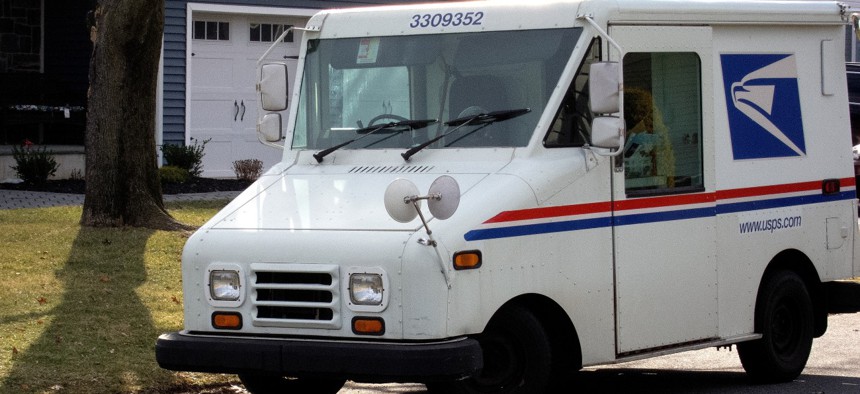
Michael Bocchieri/Getty Images
USPS Could Serve Nearly All Its Mail Routes in Electric Vehicles, a Watchdog Says
IG says it will probe contract to buy mostly internal combustion engine vans and trucks.
The U.S. Postal Service can viably support about 99% of its routes every day using all electric vehicles, according to a new analysis, which also found the increase in upfront costs may be lower than the agency has predicted.
The findings from the USPS inspector general keep pressure on postal management, which has defied the Biden administration in moving forward with its plans to replace its aging fleet with almost entirely internal combustion engine vehicles. The IG is also planning to conduct additional work concerning the mailing agency’s contract for those vans and trucks—potentially worth billions of dollars—following a request from Democratic lawmakers last week.
The average postal route requires 24 miles of driving and nearly all of them are less than 70 miles. Current technology can therefore easily satisfy USPS requirements for EV deployment, as evidenced by foreign posts and private companies already making that transition.
“The agency can, as it has in the past, take a leading role in advancing the adoption of new transportation technology,” the IG wrote in a recent white paper. "As the technology has evolved, there is no longer any question that electric vehicles can serve the functions necessary for postal delivery.”
Benefits of a more electric fleet would include not just reduced emissions, but less maintenance due to fewer moving parts, regenerative braking and the durability of batteries and motors. Energy costs would come down and stay more stable relative to gasoline.
Still, over the 20-year lifespan of the vehicles, the IG’s analysis found costs would be 11% higher for EVs compared to gas-powered vehicles. That would include the costs of buying and installing one charger for every car, though the IG speculated the Postal Service could get away with fewer as many vehicles would not require daily charging. If USPS bought only one charger for every 2 vehicles, EVs would become 8% cheaper over their lifetimes. The Postal Service could also increase savings by using the EVs on longer routes or in high gas price states like California.
Postal management took significant issue with the IG’s analysis, calling for corrections and further clarifications. It estimated, for example, that each charger would cost $18,000, whereas the IG said it would only be $7,300. The IG failed to consider the need for operational flexibility when suggesting the vehicles did not always need to stay fully charged, as well as the impact of postal-specific driving on a vehicle’s drivetrain. The IG stuck by its analysis, saying no changes were necessary.
The investigators did acknowledge some potential challenges, such as retrofitting certain facilities to support charger installation. USPS said it is engaging with local utilities to ensure it would not overtax any grids where EVs are deployed. It is also working on setting up a training center dedicated for the electric fleet.
USPS has committed to making just 10% of the 165,000 new vehicles it plans to buy electric, though Postmaster General Louis DeJoy has indicated he would be willing to go much further if Congress provided the funds. Postal management said it could fully electrify its fleet with an injection of $6.9 billion: $3 billion for the higher vehicle cost and $3.9 billion for the chargers. If such funding were provided, the IG said the lifetime cost of EVs would be 11% lower than gas vehicles. It added that USPS may be eligible for local incentives as well.
The White House and congressional Democrats have both proposed providing $6 billion for USPS to electrify its fleet, though the vehicle for that funding—the Build Back Better Act—remains in limbo. Biden has called on the entire federal government to switch to electric vehicles over the coming decades. Postal management has warned for a decade about its low cash-on-hand, though that total has skyrocketed in the last two years and sat at $23 billion at the end of 2021. USPS has for years been saddled with debt in large part due to missed statutorily required payments to its fund health care benefits for future retirees, but Congress this month passed a bipartisan bill that erased much of those negative balances.
Lawmakers are keeping pressure on DeJoy to purchase more EVs, introducing legislation to require it and calling for an investigation into the Postal Service’s initial fleet contract with Oshkosh Defense. The House members also called on the IG to probe whether USPS has met its statutory and regulatory obligations for environmental review, following pointed pushback from the White House and Environmental Protection Agency.
“We are looking at additional work to respond to the questions raised in the recent request,” said Bill Triplett, a spokesman for the IG.
The Biden administration called on the Postal Service to craft a new environmental impact study and to hold a public hearing about its plan, but postal officials last month announced they would not meet those requests. Some Democrats have since said the Oshkosh contract to purchase at least 50,000 new vehicles should be voided.







